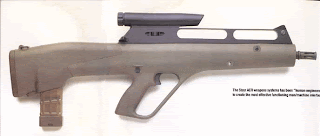This Steyr-Mannlicher ACR assault rifle was one of the finalists in the US military’s ACR competition. Unlike the other three finalists in the ACR competition, Steyr has slowly and quietly continued its development; Steyr believes that such rifles represent a possible path in the future of assault rifles. However, like all of the ACR competitors, the Steyr-Mannlicher ACR was rejected by the US military and Steyr is not trying to sell it to anyone else at this point.
Though the Steyr-Mannlicher ACR bears a superficial resemblance to the AUG, its appearance is very different than that of the AUG; it looks rather odd and vaguely ugly (at least to me, anyway). The Steyr-Mannlicher ACR used a bullpup layout, with the exterior of the rifle made of a two-part polymer shell that hinges open for stripping and cleaning. The polymer shell is strengthened with light alloy or steel reinforcement where necessary. Like the AUG, the mechanism is largely made of steel or light alloy, with the exception of a high-strength polymer hammer. Though the Steyr-Mannlicher ACR is a bullpup, it is completely ambidextrous; fire controls are duplicated on the right and left, and case ejection is downward, with the ejection port being forward of the magazine almost halfway between the magazine well and pistol grip.
(This just sounds like a bad idea from an ergonomic standpoint to me like a good way to get shells down your shirt.) The magazine well is close to the butt itself, making quick magazine changes virtually impossible in most cases, and the magazine release is behind the magazine well. The trigger mechanism, pistol grip, and large trigger guard are taken directly from the AUG, though at request of the Pentagon, the Steyr-Mannlicher ACR has a standard selector mechanism instead of the two-stage trigger of the AUG. Atop the rifle is a long carrying handle/sighting rib; this rib has a mount for a Steyr-developed 1.5-3.5x compact telescopic sight that is quite useable as a sort of ACOG-type sight, and the scope can be removed and replaced with a standard adjustable rear sight.
The operation of the Steyr-Mannlicher ACR is quite novel. The chamber’s barrel extension is not a part of the barrel; instead, it is an independent piece. Between firing cycles, this chamber piece is below barrel and in front of the magazine; a rammer picks up a round from the magazine and pushes it into the chamber piece, which then moves it to the breech where it is locked in place.
The rammer mechanism also acts as the extractor and ejector. The purpose of this operation is to provide a weapon that fires from an open bolt for cooling, yet does not have the jarring motion of the typical open-bolt weapon that can easily throw off the aim of the shooter. Steyr Mannlicher apparently supplied two versions: one that used a 3-round burst setting, and one that used a fullautomatic setting. The Steyr-Mannlicher ACR also uses a gas-piston mechanism to power its operation cycle, and, unusually for an assault rifle, utilizes a modification of a telescoping bolt design in the form of an annular ring gas piston that surrounds the bolt.
The result is a very low recoil weapon firing a high-velocity cartridge and does not need a muzzle brake to reduce recoil, but uses a very complicated mechanism. The 20.25-inch barrel projected only for a very short length outside of the shell, making a specially-designed proprietary bayonet necessary.
The ammunition designed for the Steyr-Mannlicher ACR is as novel as the rifle itself. The cases are of high-strength, heatresistant polymer, and are actually rimfire rounds. The round is a flechette, and is entirely contained within the cartridge. The muzzle velocity of the flechette is about 1500 meters per second, and the flechette reaches it’s designed maximum effective range of 600 meters in less than half a second. The trajectory is thus very flat and the high speed means that compensation for drop at even long ranges is rarely necessary – except for wind.
The Steyr SCF’s flechette (about the same size as AAI’s flechette, though even lighter in weight) suffers from the same problem that most flechettes do it is long, needle-like, very light, and fin-stabilized, making it very susceptible to wind. Steyr also had problems with the synthetic casings during the US ACR tests the cases suffered from inconsistent strength due to manufacturing difficulties, and this led to the rounds producing inconstant chamber pressures when fired. This in turn led to differences in muzzle velocity, and the trajectory of the flechettes tended to change from round to round as they were fired. Though in the figures below I have assumed perfected cartridges, the fact was that during the ACR tests, the Steyr-Mannlicher ACR could vary from dead-on accuracy to utter inaccuracy (and everywhere in between) from shot to shot. This problem was the greatest strike against the Steyr-Mannlicher ACR (apart from the usual political and bureaucratic problems.)
















0 comments:
Post a Comment